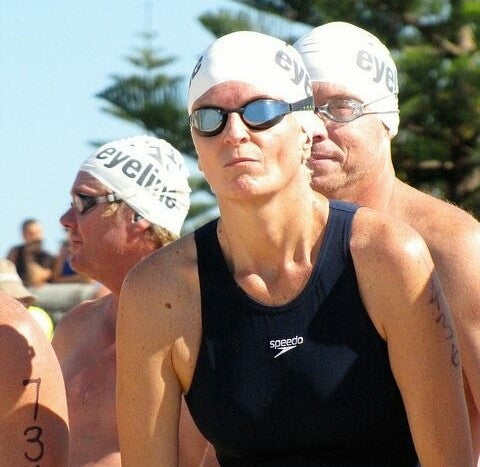Over 16 million Australian adults and children participate in sport each year1 and enjoy a huge range of benefits from it, but for outdoor sports, there is also a major disadvantage. Sun exposure.
In August 2022, I competed in the Waikiki Roughwater Swim, and came to realise that regardless of how vigilant I may be about my own sun protection there are times when it is outside of my control, when I am left to rely on the sun protection practices and policies of an organisation. I knew going into that swim in Hawaii I wasn’t allowed to wear a long-sleeved swimsuit or a rashie, so my competitor number could be written on my arm with a marker pen.
But when I arrived at the race, I heard several PA announcements telling us not to put sunscreen on the tops of our arms so that our number wouldn’t rub off. I complied with the instruction and hoped for the best. Including the waiting time and the length of the swim I was exposed in the morning sun for around two hours. I emerged from the race happy to be finished and with sunburn on the tops of my arms.
In April 2023 the Australian Age Championships were held by Swimming Australia on the Gold Coast, and it was reported that the 3,000 competitors and supporters who attended over the nine days of the event were subjected to full sun. Little to no shade was available. This event was run not only by the national sporting body, but was supported by Tourism & Events Queensland and Major Events Gold Coast, it appears that even these two government bodies from the ‘Sunshine State’ gave no consideration to sun protection in their planning.
A study which measured the dosage of UV radiation of people participating in different outdoor sports shows how at-risk sports people can be: sailing crews were exposed to 17.1 SED (Standard Erythema Dose), golfers 14.6 SED and tennis players 8.7 SED, where anything over 1 SED is considered unsafe2.
In research done of NSW cricket players, whilst the majority wore sun-protective clothing, a big tick, broad brimmed hats were uncommon. Also, only 44% of players and only 20% of their coaches had access to shade at matches3. A 2020 study from Southern Cross University found that swimmers, surfers and stand-up paddle boarders get Melanoma at a rate six times that of the general population4. As a swimmer myself I am one face to that statistic.
Sporting organisations have a huge opportunity to lead behavioural change through more focussed attention on the implementation of sun protection policies from the national bodies through to the community level. As John Wylie, former Chair of Australian Sports Commission has been quoted as saying “There’s nothing like sport as a force for social change and good”.
I was interested to understand the sun protection policies that exist in Australian sport and looked at the websites for 12 of the most popular national sporting bodies: Swim Australia, Athletics Australia, Aus Cycling, Football Australia, Tennis Australia, AFL, Netball Australia, Golf Australia, Cricket Australia, ARU, NRL and Surf Life Saving Australia. Whilst they all had a variety of different policies on their websites, I could only find sun protection policies for the last two.
To understand in a small way the real consequences of living a sporting life in the Australian sun a quick Google search revealed a non-exhaustive list of elite athletes who have had their own brush with skin cancer:
- Swimmers - Cate Campbell, Mack Horton, Susie Maroney, and Sam Short
- Footballers - Ray Price, Dermot Brereton, Jim Stynes, Jarryd Roughhead, David Cervinski and Jack Riewoldt
- Cricketers - Max Walker, Ian Chappell, Peter Taylor, Matthew Hayden, Greg Matthews, Michael Clarke and Richie Benaud
- Tennis -John Newcombe
- Pro surfing – Wayne 'Rabbit' Bartholomew, Mark Richards, Jamie Mitchell, Jane Paterson
- Golfer – Adam Scott
This begs the question, how many other people who play sport are affected?
In December 2023 a great step in the right direction has been made with the Australian Institute of Sport (AIS) releasing its Positioning Statement on sun protection. This is a major catalyst for helping to change sun protection behaviours in Australia and make a sustainable impact on our skin cancer rates. The AIS being an arm of the Australian Sports Commission does not have regulatory authority or power to enforce compliance or regulations, so the success, or otherwise, of this Positioning Statement will come down to leadership in the individual sporting bodies.
I call on all the national sporting bodies to take up a leadership position and champion the implementation and governance of sun protection policies, right through to the grass roots of their sporting community.
1https://www.health.gov.au/topics/sport/about-sport-in-australia#:~:text=About%2013%20million%20adults%20and,and%20active%20recreation%20each%20year.
2Morton, Harrison. 2023. Slip, Slop, Slap, Slide, Seek and Sport: A Systematic Scoping Review of Sun Protection in Sport in Australasia. Current Oncology. 2023, 30(1), 401-415.
3Ibid
4https://www.scu.edu.au/engage/news/latest-news/2020/skin-checks-reveal-dark-side-of-sun-exposure-for-surfers-swimmers-sups.php
